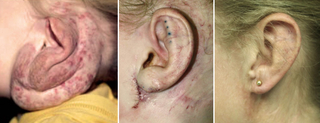What are ear hemangiomas

Hemangiomas are the most common benign tumor of infancy. Hemangiomas can occur anywhere on the body, including on and around the external ear and the salivary gland in front of the ear (parotid gland). Ear hemangiomas often distort the shape of the ear, which can result in permanent external ear deformities. Parotid hemangiomas compress the external ear canal and stretch the skin of the cheek in front of the ear.
Causes
Infantile hemangiomas are the most common type of hemangioma, and usually appear within the first few weeks of life. They generally grow during the first year of life and then slowly shrink over the next several years. Some types of hemangiomas are present at birth. In some cases, these shrink (or involute) rapidly within the first year of life (rapidly involuting congenital hemangioma, also called RICH), while others do not shrink (noninvoluting congenital hemangioma, or NICH).
Treatment
Many hemangiomas will completely resolve by the time the child is 5 years old with nothing less than observation. However, beta blockers such as Timolol gel and oral Propranolol have been shown to slow the growth of hemangiomas. Timolol gel can be prescribed by your surgeon. It is applied two times a day to the site. Oral Propanolol is reserved for children with large hemangiomas or hemangiomas that interfere with important structures of the face, such as the ear. CHOP’s Dermatology Section will prescribe and manage oral Propanolol therapy. Despite preventative treatment, ear hemangiomas can cause ear deformities. Surgery for ear hemangiomas involves the removal (excision) of extra skin and fatty scar tissue, and in some cases, surgical reconstruction of the ear.
Any remaining red or purple pigmentation (coloring) can be treated with laser therapy.

Lateral view of large ear hemangioma in infancy (left), after surgical debulking (middle), and after ear piercing as teenager.
Why choose us?
CHOP provides multidisciplinary treatment for vascular anomalies such as ear hemangiomas. Specialists from plastic surgery, dermatology, interventional radiology, ophthalmology and neurology meet monthly to review complicated cases and ensure your child is receiving the best possible coordinated care. CHOP’s Division of Plastic, Reconstructive and Oral Surgery also has a dedicated Vascular Anomalies Program where children have access to a team of experts who specialize in treating vascular anomalies.
Resources to help
Reviewed by David W. Low, MD
